2011 Finalist
Book Award Years
Winner
Finalists
Boniface Mwang i- Mungiki Crackdown - Brutality
The violent police crackdown on people suspected to be adherents of the outlawed Mungiki sect in the sprawling Mathare, Valley of Death, is still fresh in the minds of many. The residents of Mathare residents will forever remember June 2007 for it's the month that armed police backed by the dreaded General Service Unit turned the slum into a killing field to avenge the killing of two colleagues on the night of June 4. A major security operation, which was launched two days later to recover the guns of the slain officers, left a trail of blood and tears in Mathare.
When the guns fell silent, 14 people lay dead, most of them shot at close range or from the back either having surrendered or simply been cornered. Only police themselves knew the formula of determining who got shot and who didn't in an operation that was clearly one of the biggest in recent times. Many other residents were left nursing broken jaws and limbs. Mothers and their young children spent cold nights as the police and their agents turned the shanties they call home into slaughterhouses.
In November 2007, a report by a group of Kenyan lawyers was released showing that as many as 8,040 young Kenyans have been executed or tortured to death since 2002, during a five-year police crackdown on the outlawed Mungiki sect, according to a report. Another 4,070 young men have gone missing between August 2002 and August 2007 after being held in police custody, said the report by the Oscar Foundation Free Legal Aid Clinic in Kenya.
The state-funded Kenyan National Commission on Human Rights (KNCHR) linked police to the deaths of more than 450 young men in the past five months in a crackdown on Mungiki. The KNCHR said in a report that police had executed nearly 500 men between June and October 2007 and dumped their bodies in mortuaries and settlements outside Nairobi during a months-long crackdown on the ultra-violent Mungiki gang.
Mungiki claims to have thousands of adherents, all drawn from the Kikuyu, Kenya's largest tribe. The group, whose name means "multitude" in the Kikuyu language, was inspired by the bloody Mau Mau rebellion. Mungiki began as a group promoting traditional Kikuyu practices, including female genital mutilation, but gradually became involved in extortion, murder and providing hired muscle to politicians.
On the 5th March 2009, Mr. John Paul Oulu (also known as GPO) and his boss Mr. Oscar Kamau King'ara the founder of the Oscar Foundation were executed in cold blood by a group of men in two vehicles. The two human rights defender were driving to meet Mr. Kamanda Mucheke of the Kenya National Commission on Human Rights at his office. Eyewitnesses said that the assassins were policemen. In fact, the minibus driver was in police uniform.
Oscar Foundation is a registered charitable organization that offers free legal services to the poor. Some of its major projects include organizing caravans to offer free legal aid to the poor throughout the country. They have a strong track record researching corruption in the police forces, the prisons, and police brutality against the urban poor. The latest activity was researching and documenting cases of enforced disappearances and extra-judicial killings.
Critics of the government believe the human rights lawyers were killed because of the sensitive information they had shared with both the Prof. Philip Alston the UN Special Envoy on Human Rights, and with Members of Parliament. The Oscar Foundation has been a major source of information to Parliament on atrocities playing out against the poor in the country. Their last engagement with Parliament was a presentation to the Kioni Committee investigating organized gangs a few days before they were killed.
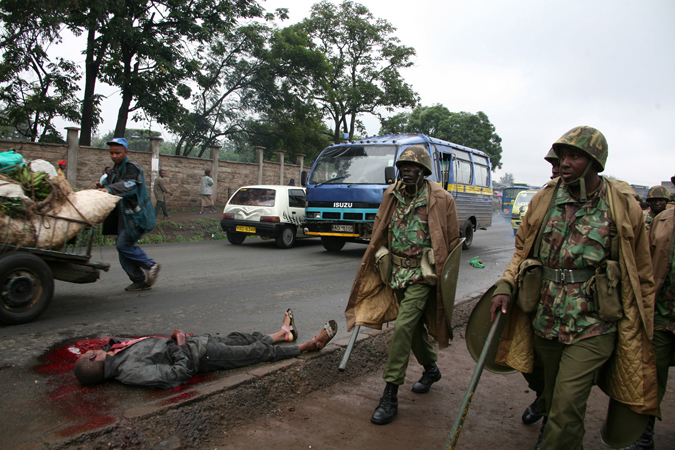
Paramilitary police walk past an opposition supporter’s body in Mathare slums in January 2008 during new inter-ethnic violence in Kenya. The post-election violence started amid allegations that the incumbent president manipulated the December elections. Over 1000 people were killed and 500,000 displaced.

A plainclothes police officer walks past a spot where a suspect was shot during a crackdown on Mungiki sect adherents in Kosovo slum in Nairobi; Kenya on June 7, 2007. When the guns fell silent, 14 people lay dead, most of them shot at close range or from the back either having surrendered or simply cornered.

A woman cries after supporters of presidential candidate Raila Odinga set fires at the Mathare slum in Nairobi, 30 December 2007, three days after Kenyans went to the polls to elect a new President. Kenyan police shot dead five people demonstrating against President Mwai Kibaki's re-election as angry supporters of defeated opposition leader Raila Odinga went on a rampage in major cities.

A woman kneels down to surrender during a crackdown on Mungiki sect adherents in Kosovo slum in Nairobi, Kenya in June of 2007. The sect is blamed for a string of recent murders and beheadings. The slum was believed to be a major hideout for the quasi-religious, militant sect members.

A supporter of Presidential candidate Raila Odinga (R) is beaten by two supporters of Presidential candidate Mwai Kibaki (C) and (L) during a street fight in the Mathare neighborhood of Nairobi, Kenya, December 29, 2007.

A mungiki suspect is mauled by a police dog, while the officers laugh during a crackdown on Mungiki sect adherents in Kosovo slum in Nairobi, Kenya on June 7, 2007.

Opposition supporters retreat while engulfed by teargas smoke in Mathare on January 17, 2008 in Kenya. International mediators have attempted to unlock political gridlock in the East African nation, which has lost 600 people in severe post-election violence amid allegations that the incumbent president manipulated the elections.
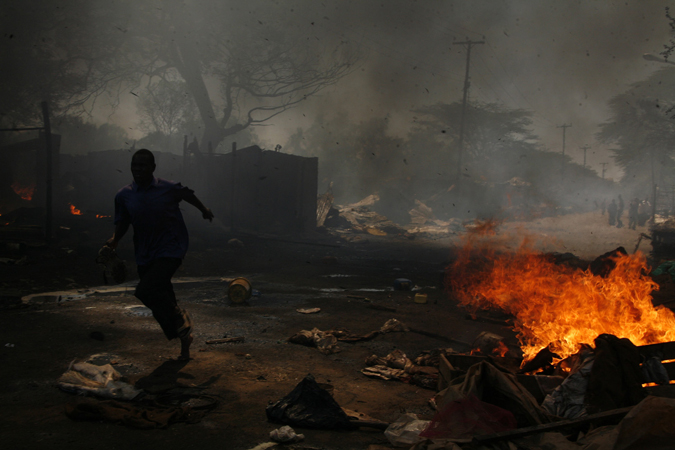
A man run’s past burning structure during fresh violence in Kibera slums in Nairobi Kenya. The post-election violence started amid allegations that the incumbent president manipulated the elections. The political dispute has degenerated into ethnic violence nationwide pitting Kibaki's influential Kikuyus against Odinga's Luos and other tribes. The violence has killed over 1000 people and left over 500,000 displaced.

A mother, on the right, cries over the body of her 13 year old daughter who was shot dead by police, in the Kibera slums, Nairobi, January 18, 2008. Kenyan police shot dead four people in the slums during the operation on the last day of rallies against President Mwai Kibaki's re-election.
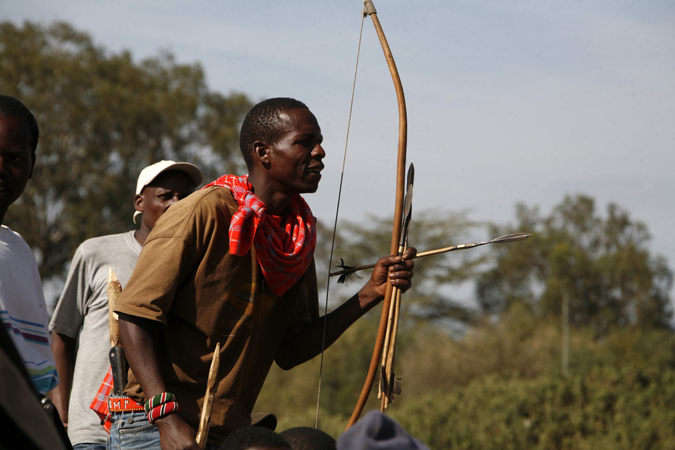
A man armed with bow and arrow in Nakuru, one of the hotspots during post election violence in Kenya. The political dispute has degenerated into ethnic violence nationwide pitting Kibaki's influential Kikuyus against Odinga's Luos and other tribes that has killed over 1000 people and left over 500,000 displaced.
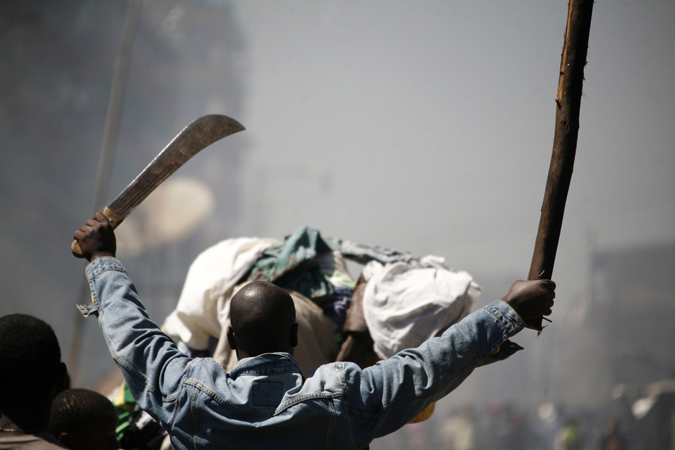
A man with a club and a machete raises his arms in triumph as a mob ran riot and attacked people and set houses and businesses on fire in the slum of Mathare after inter-ethnic conflict erupted overnight and into the morning in Nairobi, Kenya on January 2, 2008. At least 260 people were killed that day across the country in political and inter-ethnic violence.

A short sleeve amputation during ethnic violence in Kenya. The political dispute has degenerated into ethnic violence nationwide pitting Kibaki's influential Kikuyus against Odinga's Luos and other tribes that has killed over 1000 people and left over 500,000 displaced.
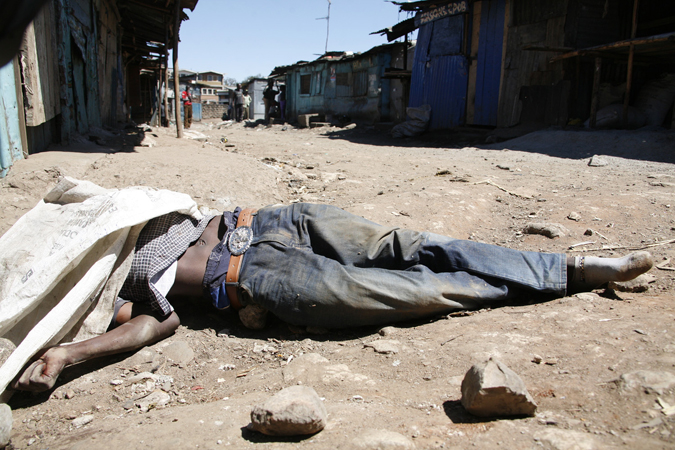
The body of one young man who had been hacked to death lay in a muddy alley. His face was covered with plastic bags and his shoes had been stolen. Police said it was too dangerous to enter the slum to retrieve the body.

A relative weeps over the body of man who was shot by police during post-election violence amid allegations that the incumbent president manipulated the December elections.

Scared school children walk past a police dog during a crackdown on Mungiki sect adherents in Kosovo slum in Nairobi; Kenya on June 07, 2007. The sect is blamed for a string of recent murders and beheadings. The slum was believed to be a major hideout for the quasi-religious, militant sect members.
